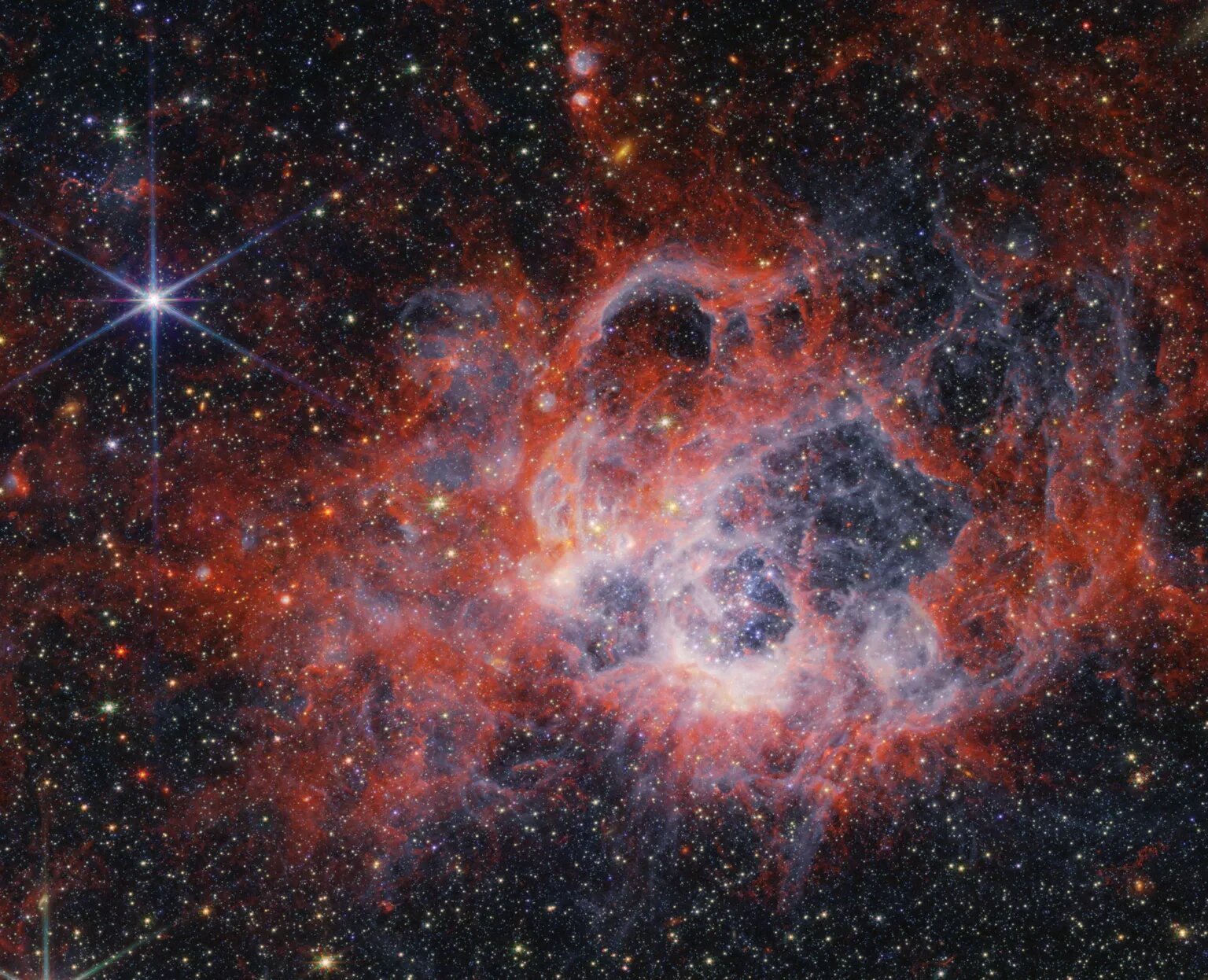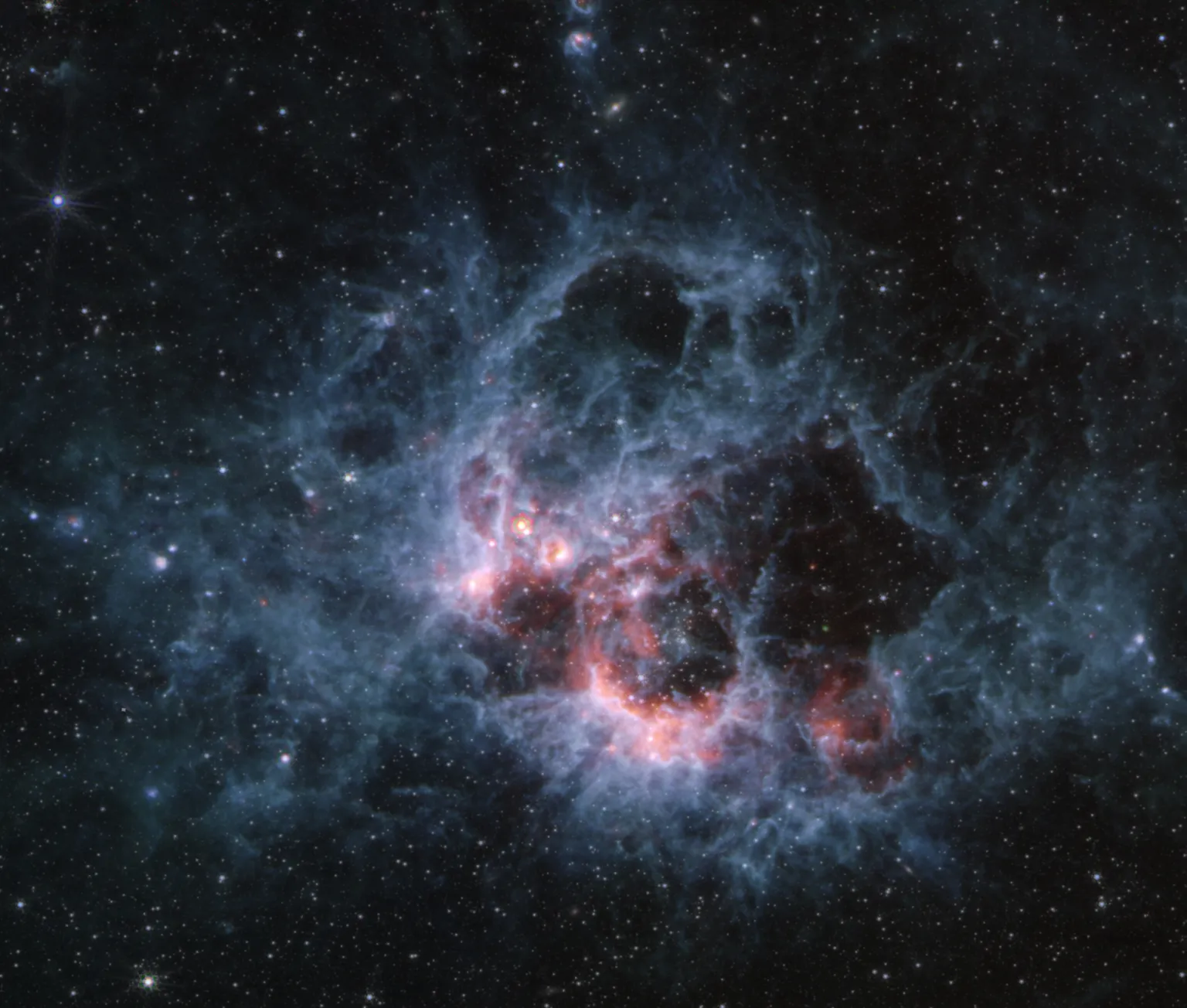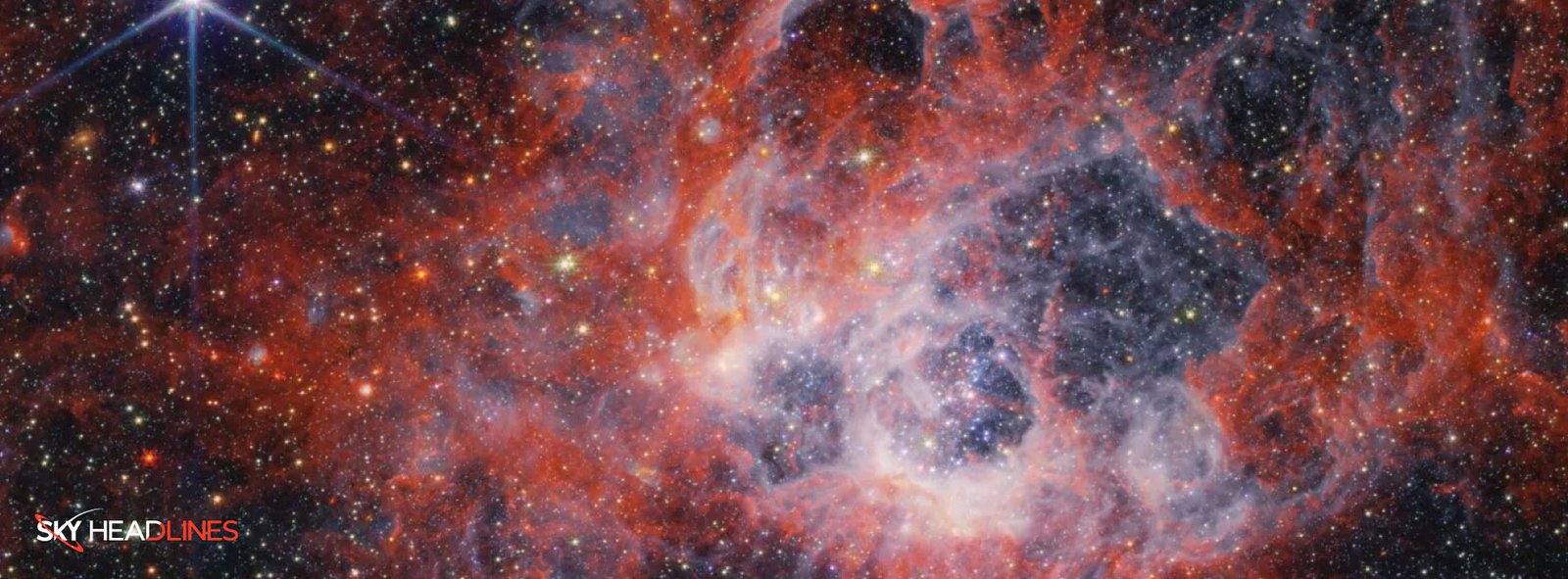A Look at NGC 604 with the James Webb Telescope
The cosmos, with its vastness and enigmatic phenomena, continues to captivate astronomers’ curiosity. Among the celestial wonders, the star-forming region NGC 604, nestled within the Triangulum galaxy (M33), stands out as a captivating tapestry of stellar birth. The latest insights, revealed by NASA’s James Webb Space Telescope, unravel the intricacies of NGC 604, offering a closer look at the formation of stars in this unique cosmic haven.
Is NGC 604 in Galaxy M33?
Yes, NGC 604 is located in the Triangulum Galaxy, also known as M33 [ESA/Webb]. It’s a massive star-forming nebula residing within one of the galaxy’s spiral arms.
JWST’s Infrared Eyes: Revealing NGC 604’s Stellar Bonanza
JWST’s keen eyes, peering through the dusty veil of NGC 604, have captured two remarkable images using its NIRCam (Near-Infrared Camera) and MIRI (Mid-Infrared Instrument). These images unveil a breathtaking tapestry of star birth, showcasing intricate filaments and cavernous bubbles carved into the gas clouds. Within these dusty envelopes reside over 200 young stars, burning brightly at the dawn of their stellar lives. These stellar newborns belong to the O and B-type classifications, boasting masses that can exceed 100 times that of our Sun. Finding such a high concentration of these behemoths is a rare occurrence in our cosmic neighborhood, with no similar region existing within the Milky Way.
This unique combination of a massive stellar population and relative proximity makes NGC 604 an invaluable laboratory for astronomers. Studying these young giants during their formative years provides crucial insights into the early stages of stellar evolution. We can potentially observe the powerful stellar winds shaping the surrounding gas and dust, the intense ultraviolet radiation triggering the formation of ionized bubbles, and the interplay between these forces that influence the future generations of stars within the nebula.

Decoding NGC 604: JWST’s Close-up on the Tapestry of Star Birth
The NIRCam image reveals a captivating scene dominated by tendrils and clumps of gas glowing a vibrant red. These tendrils emanate from clearings, vast bubble-like structures sculpted by the fierce winds blasting from the most luminous young stars. The hot, young stars also unleash a torrent of ultraviolet radiation, ionizing the surrounding gas. This ionized hydrogen manifests as an ethereal white and blue glow.
Further enriching the image are the bright orange streaks, signifying the presence of complex carbon-based molecules called polycyclic aromatic hydrocarbons (PAHs). These molecules play a crucial role in the interstellar medium, influencing the formation of stars and planets. However, their origin remains an intriguing enigma. As we delve deeper into the image, away from the well-defined clearings, the red hue deepens, indicating the presence of cool molecular hydrogen gas. This cooler gas serves as the fertile ground for future generations of stars.
The remarkable resolution of JWST unveils previously hidden details. For instance, the NIRCam image reveals two vibrant young stars carving out cavities in a dust layer above the central nebula. These stars seem connected by a faint, reddish gas filament. In earlier visible-light images captured by the Hubble Space Telescope, these structures appeared as separate entities. Analyzing the dynamics of these young stars and their interaction with the surrounding gas can provide valuable insights into the early stages of star cluster formation.
A Different Perspective Through Mid-Infrared Light
JWST’s MIRI image offers a contrasting view of NGC 604, showcasing the region through the lens of mid-infrared wavelengths. This perspective reveals a significant reduction in the number of visible stars. Hot stars emit significantly less light at these wavelengths, while the vast, cooler gas clouds and dust come to the forefront, glowing brightly.
The MIRI image also unveils the presence of red supergiants, colossal stars residing within the Triangulum Galaxy itself. These stars, though cool in temperature, possess immense size, boasting diameters hundreds of times greater than our Sun. Additionally, many background galaxies visible in the NIRCam image fade away in the MIRI view. Interestingly, the blue tendrils of gas persist in the MIRI view, once again signifying the presence of PAHs. This consistency highlights the widespread presence of these molecules within the nebula and emphasizes the need for further research into their formation mechanisms.

How far away is NGC 604?
NGC 604 is a staggering 2.73 million light-years away from Earth [Webb Space Telescope]. That’s a vast distance, even by astronomical standards! It resides in the Triangulum Galaxy (M33).
A Stellar Nursery Unveiled
NGC 604 is estimated to be roughly 3.5 million years old, a mere infant in the grand cosmic timescale. This vast stellar nursery stretches for an impressive 1,300 light-years across. With the invaluable data provided by JWST, astronomers are now unraveling the intricate processes governing star birth within NGC 604. The insights gleaned from this region will not only shed light on the early lives of massive stars but will also enhance our understanding of star formation across the cosmos.
A Glimpse into the Future
As JWST continues its observations, we can expect even more captivating revelations about this stellar nursery. Studying the interaction between the young stars, the evolving gas and dust clouds, and the formation of potential protoplanetary disks around these stars will offer unprecedented insights into the very birthplaces of planetary systems. Are there similarities in the formation processes of planets around massive stars compared to those around Sun-like stars? Do these young giants influence the composition and characteristics of any forming planetary systems? These are just some of the questions that JWST’s observations of NGC 604 can potentially answer.
Furthermore, the detailed analysis of the gas filaments within NGC 604 can provide valuable clues about the role of turbulence and magnetic fields in the star formation process. These intricate structures play a crucial role in channeling gas towards nascent stars, influencing their mass and potentially even their spin. By studying the dynamics of these filaments in NGC 604, astronomers can refine existing models of star formation and gain a deeper understanding of how these celestial giants come to be.
NGC 604 serves as a stepping stone for astronomers, offering a unique window into the early stages of star formation within a relatively nearby galaxy. The knowledge gleaned from this region can be applied to understand similar processes occurring in more distant galaxies, pushing the boundaries of our cosmic understanding. As JWST continues to unveil the secrets of NGC 604, we can expect a paradigm shift in our knowledge of stellar birth and the formation of massive stars, ultimately enriching our perspective on the grand narrative of star and galaxy evolution.
Beyond the scientific significance, the captivating imagery provided by JWST offers a glimpse into the raw beauty and dynamism of star formation. The intricate dance of gas and dust, the sculpting power of stellar winds, and the birth of colossal stars paint a breathtaking picture of the ongoing drama within NGC 604. These images serve as a powerful reminder of the vastness and wonder of the universe, igniting our curiosity and inspiring future generations to explore the cosmos.





